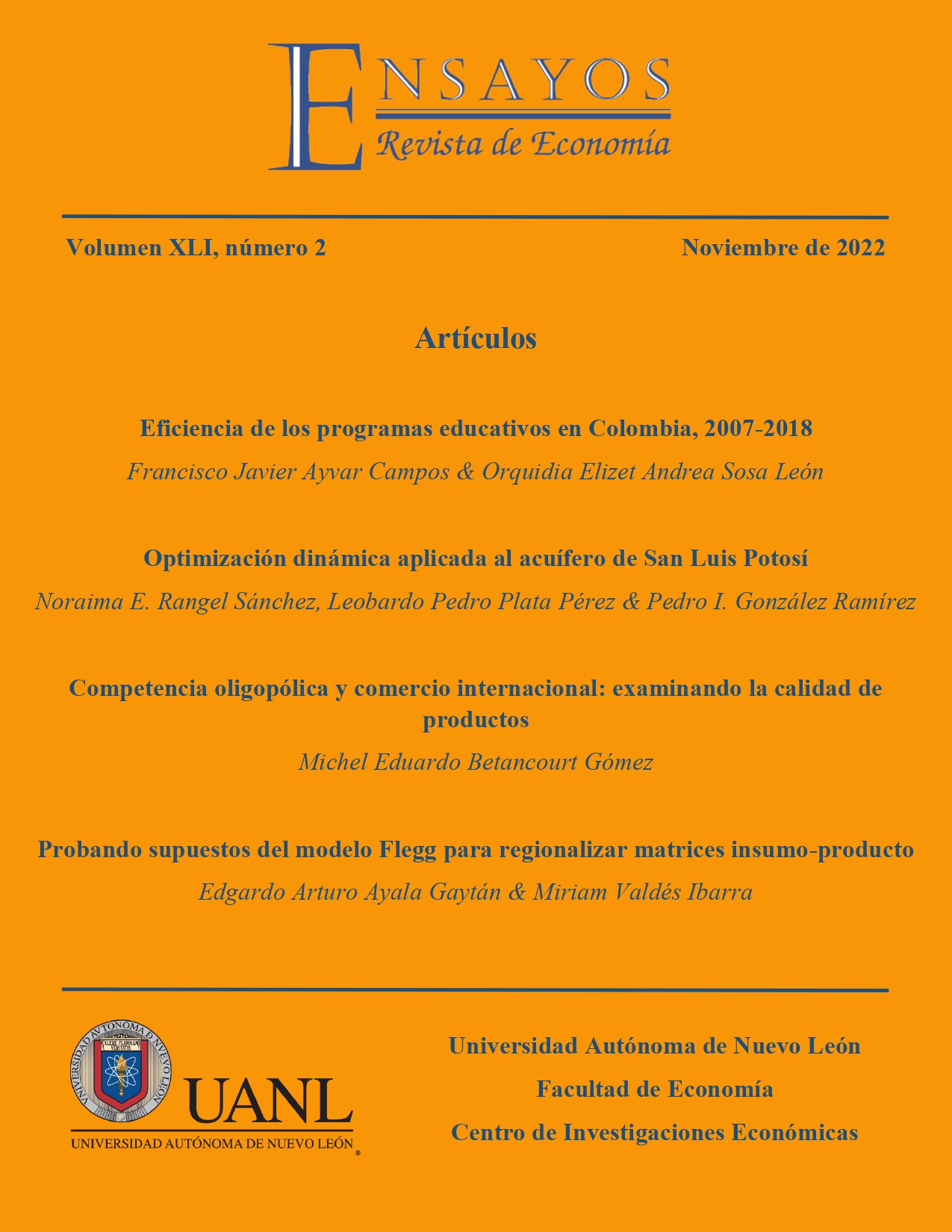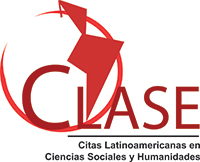Testing Flegg model assumptions for regionalizing input-output tables
Probando supuestos del modelo Flegg para regionalizar matrices insumo-producto
DOI:
https://doi.org/10.29105/ensayos41.2-4Keywords:
Regional input output tables, Regionalization by quotas, FLQ Formula, Indirect methods.Abstract
Flegg's location quotient (FLQ) is one of the most popular non-survey methods for obtaining regional input-output tables. This method is widely adopted due to the minimum information requirements and the precision and accuracy of estimates. In this work, the assumptions of the method are econometrically contrasted with information from European Union and nine European countries. It is found that the simple location quotas of the seller's sector are more important than the ones of the buyers. Still, the FLQ model's predictive power is only slightly lower than more complex models, which reinforces the practical efficiency of the FLQ formula.
Downloads
References
Ayala, E. y Chapa, J., 2019. Demanda agregada y desigualdad regional por género en México. Cuadernos de Economía, XXXVIII, Julio-Diciembre, 399-424.
Ayala, E., Chapa, J. y Treviño, L., 2015. Análisis estructural de la región petrolera del Golfo-Sureste de México, en un contexto interregional, Equilibrio Económico, 11 (2), 135-168.
Ayala, E., Chapa, J., Treviño, L., Matteo, G. y Pérez, F., 2015. Efectos regionales del libre comercio: el caso del noreste de México. Pearson, Ciudad de México.
Barro, R. J. y Sala-I-Martin, X., 1992. Convergence, Journal of Political Economy, 100 (2), 223-251.
Bonfiglio, A., 2009. On the parametrization of techniques for representing regional economic structures. Economic Systems Research, 21 (2), 115-127.
Bonfiglio, A. y Chelli, F., 2008. Assessing the behavior of non-survey methods for constructing regional Input-Output tables through a Monte Carlo simulation. Economic Systems Research, 20 (3), 243-258.
Cappelen, A., Castellacci, F., Fagerberg, J., y Verspagen, B., 2003. The Impact of EU Regional Support on Growth and Convergence in the European Union. JCMS, 41(4), 621-44.
Chapa, J. y Ayala, E., 2018. Valoración del trabajo y equidad de género en México. Pearson, Ciudad de México.
Dávila, A. y Valdés, M., 2012. Jalisco: Modelos de producción insumo-producto 2003-2008. Econoquantum, 10(2), 99-133.
Dávila, A., 2015. Modelos interregionales de insumo-producto de la economía mexicana. Universidad Autónoma de Coahuila y Miguel Ángel Porrúa, Ciudad de México.
Dávila, A., 2019. Modelos económicos de las regiones de México. Universidad Autónoma de Coahuila y Miguel Ángel Porrúa, Ciudad de México.
Espositi, R., y Bussoletti, S., 2008. Impact of Objetive 1 Funds on Regional Growth Convergence in the European Union: A Panel-data Approach. Regional Studies, 42(2), 159-173, March 2008.
Eurostat (2013), National Accounts ESA, Input-Output Tables 2010.
Flegg, A., Webber, C. and Elliot, M., 1995. On the appropriate use of location quotients in generating Input-Output tables. Regional Studies, 29, 547-561.
Flegg, A., y Webber, C., 1997. On the appropriate use of location quotients in generating Input-Output tables: Reply. Regional Studies, 31, 795-805.
Flegg, A., y Webber, C., 2000. Regional size, regional specialization and the FLQ formula. Regional Studies, 34 (6), pp. 563-569.
Flegg, A. y Thomo, T., 2011. Regional Input-Output tables and the FLQ formula: a case study of Finland”. Regional Studies, 47, 703-721.
Flegg, A. y Thomo, T., 2016a. Estimating regional input coefficients and multipliers: the use of the FLQ is not a gamble. Regional Studies, 50 (2), 310-325.
Flegg, A. y Thomo, T., 2016b. Refining the Application of the FLQ Formula for estimating regional input-output coefficients: An empirical study for South Korean regions. Economics Working Paper Series, 1605, Bristol University of West England.
Flegg, A., Mastronardi, L., y Romero, C., 2015. “Evaluating the FLQ and AFLQ Formulae for Estimating Regional Input Coefficients: Evidence from the Province of Cordoba, Argentina”. Economics Working Paper Series, 1508, Bristol University of West England.
Gaytán, E. D., y del Pilar Riaño, J. (2015). Matriz de insumo-producto de la economía de Colombia: detección de efectos multiplicadores y determinación de flujos intersectoriales más relevantes. Brazilian Geographical Journal: Geosciences and Humanities research medium, 6(2), 49-66.
Gaytán Alfaro, E.D., Mendoza Sánchez, M.A., y Vargas Sánchez, J.R., 2018. Minería y encadenamientos productivos en México: un estudio comparativo empleando modelos estatales de insumo-producto. Economía Coyuntural, 3(2), 2-32.
Lamonica, G., Recchioni, M., Chelli, F. y Salvati, L., (2020) The efficiency of the cross-entropy method when estimating the technical coefficients of input–output tables, Spatial Economic Analysis, 15(1), 62-91.
González Ramírez, P., de la Cruz Meraz, M.I. y Neri Guzmán, J.C., 2020. Aplicación de la técnica FLQ para la obtención de las matrices insumo-producto en la economía mexicana. Regiones y Desarrollo Sustentable, 20(39).
Jahn, M., 2017. Extending the FLQ formula: a location quotient-based interregional input–output framework. Regional Studies, 51(10), 1518-1529.
Mardones, C., y Hernández, A. (2017). Análisis de subsidio al sector silvícola de la región del Biobío, Chile. Madera y bosques, 23(2), 53-68.
Mastronardi, L. J., y Romero, C. A., 2012. Estimación de matrices de insumo-producto regionales mediante métodos indirectos. Una aplicación para la ciudad de Buenos Aires. MPRA Paper, 37006.
Miller, R.E. y Blair, P.D., 2009. Input-output analysis: foundations and extensions. Cambridge university press.
Ramos Ruiz, J. L., Polo Otero, J. L., y Arrieta Barcasnegras, A., 2017. Análisis insumo-producto y la inversión pública: una aplicación para el Caribe colombiano. Cuadernos de Economía, 36(70), 137-167.
Romero, C.A., Mastronardi, L.J., y Faye, M.J., 2012. "Análisis de coeficientes de localización. El caso de la provincia de Córdoba [Location quotient analysis. The case of Cordoba state]," MPRA Paper 36997, University Library of Munich, Germany.
Sanabria-Bautista, C. F., Cely- Acero, J.P., 2018. Análisis del insumo-producto: una aplicación para la economía boyacense. Vestigium Ire., 12(2), 53- 68.
Temursho, U., Oosterhaven, J. y Cardenete, M.A., (2021) A multi-regional generalized RAS updating technique, Spatial Economic Analysis, 16(3), 271-286.
Torre Cepeda, L. E., Alvarado Ruiz, J. A., y Quiroga Treviño, M. (2017). Matrices insumo-producto regionales: una aplicación al sector automotriz en México (No. 2017-12). Working Papers.
Thomo, T., 2004. New developments in the use of location quotients to estimate regional input-output coefficients and multipliers. Regional Studies, 38 (1), 43-54.
Vera Vázquez, R. y Langle Flores, M.A., 2019. Flexibilización del modelo de insumo-producto para determinar interdependencias productivas en la ciudad fronteriza de Reynosa, Tamaulipas, 2013. Estudios fronterizos, 20.
Downloads
Published
How to Cite
Issue
Section
License
Copyright (c) 2022 Edgardo Arturo Ayala Gaytán, Miriam Valdés Ibarra

This work is licensed under a Creative Commons Attribution 4.0 International License.
















